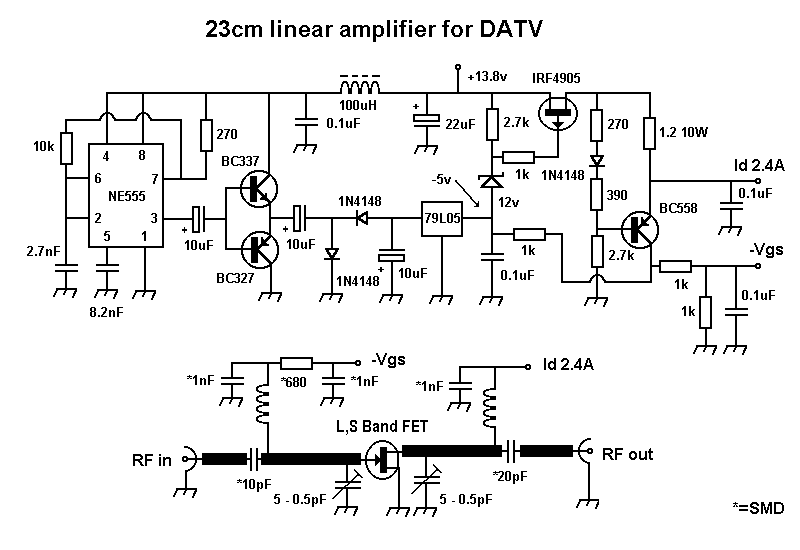UHF Amplifiers
UHF Amplifiers
VSB Modulator
|
Philips TV IF modulator PM5580 My ATV test set up for channel 39 is a Philips TV IF modulator PM5580 and the PM5582 UHF up converter. The main problem was the UHF up converter was not on channel 39 to begin with. After spending three days working my way through the different modules. I found away of shifting UHF channels. |
 |
The PM5582 The range can be any UHF channel from E-21 to E-69. When I got my unit it was on channel 54, It is now set up on channel 39. The drive out from the PM5582 is more then enough to feed into the BFQ68 amplifier stage. |
The Barco NE-728 I can also generate NICAM at an IF, that is mixed in with the vision IF at 38.9 MHz of the PM5580. The Barco NE-728 is at a lower level then what the philips unit is. To get around this problem I needed put a 10 dB amplifier together. |
Television Amplifiers
For television, all RF amplification must be linear as possible, as they operate in class A or AB modes. Remember that television is a composite signal, if the amplifier is not keep linear, it is all too easy to suffer intermodulation. When this happens the picture does not look very good, but more importantly you will cause intermodulation and remix in the lower sound carrier as well as NICAM carrier overlapping the allocated TV channel. For power levels below ten watts this is not too much of a problem.

For ten watts or more, an RF output filter is a good idea. If the amplifier goes nonlinear, the output products are keep within the UHF channel. Output filters typically used are interdigital types, 5 pole or more with a notch at the -5.5 MHz frequency to suppress the regenerated sound subcarrier. The circulator is in line to provide a constant 50 ohms impedance for the output of the power amplifier to keep it stable. Dummy load temperature should be monitored if possible.
50 cm band ATV amplifiers
RF amplifier bias design information
Old amplifier line up

New amplifier line up

The amplifier line up begins with the BDG802 wide band amplifier module. Next is the BFQ68 transistor low level drive stage up to about 700 mW output. The BLV103 transistor stages are providing the drive power needed for the power amp to about 5 Watts. The power amplifier stage uses a LDMOS FET. It's maximum output can be as high as 200 Watts. But the driver stage can only push this amplifier to the 100W level. All low level amplifiers stages work at 24 volt dc, the power amp stage works 32 volts dc at 20 amps.
50CM Linear class A pre driver stage
In the construction of an Amateur Television repeater station transmitter for the 50cm band (channel E39 615.25 MHz) a pre-driver stage was needed to precede the BFQ68 driver amplifier, where the exciter power is less than 20 milliwatts. This design is the result. More than ten of these amplifiers are now in use around New Zealand.
The amplifier is biased to be linear with an average DC current draw of 77 milliamps from the 12 Volts supply regardless of the RF drive conditions. In fact the amplifier draws the same current when there is no RF drive. Whilst the BFR96S transistor is a 700 milliwatts maximum dissipation device for CW or FM, the output power for good quality Television must be limited to 100 milliwatts average, when this amplifier is connected directly to the aerial. At higher output power than this, inter modulation products increase markedly and synch pulse crushing of the RF output waveform takes place. The RF drive level from the exciter unit is adjusted so that an output level, of 20 to 100 mW, is produced to drive the following BFQ68 amplifier stage within its' TV linear power range.
The pre-set bias control is initially set for a current draw of 77 milliamps for the whole amplifier, including the bias circuit. Its' setting is fine tuned by adjusting for best linearity of the RF output waveform using an oscilloscope and demodulator probe with a grey scale video signal applied to the modulator.


By Wayne Griffin ZL1UJK
